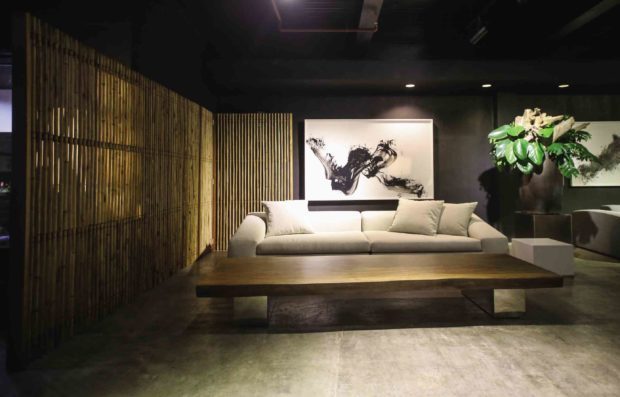
A decade ago, furniture designer Milo Naval was tapped by a home magazine to furnish and style the Courtyard House of Swiss architect Sacha Cotture.
When Naval went around the house, he felt an affinity to Cotture’s aesthetics. It was built with local organic materials, fine wooden poles for exterior walls and natural stone for accent walls. The colors were basic, whites and grays, and the lines were simple and clean, similar to Naval’s furniture.
Cotture has since included “painter” in his resumé. After learning Chinese painting,
he developed his own style—
making intense and impulsive strokes, or splashing the paint and letting it drip.
For texture, he uses a walis tambo instead of paintbrush. Many of his works apply the wet-on-wet method—a watercolor technique in which another layer of wet paint is applied on wet paint. The colors spread into one another, resulting in melding tones and soft edges. He favors salt water to wet the Chinese ink for texture.
Impressed with Cotture’s artworks, Naval displays them to complement his furniture collections at the OMO showroom at LRI Design Plaza in Makati.
Focus to space
In design projects, Naval uses art sparingly to maintain the calmness of his signature neutral color scheme. Meanwhile, the scale and the stark simplicity of Cotture’s Chinese black ink on white paper make an impact.
“They bring focus to the space,” said Naval.
Cotture, noting similarities with Naval’s artistic style, remarked: “We both have a taste for the organic. My architecture and paintings are close to what Milo does—using simple, natural materials and putting them together dynamically.”
Naval and Cotture draw inspiration from their environment. Naval works with fallen trees, rattan, bamboo, pili nut shells and other materials sourced from his adopted province, Sorsogon.
Cotture’s themes are about hills, mountains and the water. “Everything I do reflects movement,” he said.
He works in the open courtyard at home because the ink dries quickly under the sun. “I have to paint outside even if we live in a country with terrible monsoons,” he pointed out. “If there is risk of getting wet, I will not start an artwork that requires brushes. I’ll splash the ink or let loose on the paper. If I work indoors, I have to wait for hours for the paint to dry, then I’m stuck. I need to keep producing.”
Cotture’s large-format paintings complement the generous proportions of Naval’s sofas and tables. The artworks’ lack of color harmonizes with Naval’s palette of neutrals, whites, beige, gray and a touch of black. The fluid movements of the paintings offset the no-nonsense straight lines of Naval’s furniture.
Naval said displaying artworks in his furniture showroom aims to show people how correctly-sized work can make a powerful statement, or a welcome addition to a space. —CONTRIBUTED